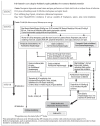Pediatric Sepsis Guidelines: Summary for resource-limited countries
- PMID: 20606908
- PMCID: PMC2888329
- DOI: 10.4103/0972-5229.63029
Pediatric Sepsis Guidelines: Summary for resource-limited countries
Abstract
Justification: Pediatric sepsis is a commonly encountered global issue. Existing guidelines for sepsis seem to be applicable to the developed countries, and only few articles are published regarding application of these guidelines in the developing countries, especially in resource-limited countries such as India and Africa.
Process: An expert representative panel drawn from all over India, under aegis of Intensive Care Chapter of Indian Academy of Pediatrics (IAP) met to discuss and draw guidelines for clinical practice and feasibility of delivery of care in the early hours in pediatric patient with sepsis, keeping in view unique patient population and limited availability of equipment and resources. Discussion included issues such as sepsis definitions, rapid cardiopulmonary assessment, feasibility of early aggressive fluid therapy, inotropic support, corticosteriod therapy, early endotracheal intubation and use of positive end expiratory pressure/mechanical ventilation, initial empirical antibiotic therapy, glycemic control, and role of immunoglobulin, blood, and blood products.
Objective: To achieve a reasonable evidence-based consensus on the basis of published literature and expert opinion to formulating clinical practice guidelines applicable to resource-limited countries such as India.
Recommendations: Pediatric sepsis guidelines are presented in text and flow chart format keeping resource limitations in mind for countries such as India and Africa. Levels of evidence are indicated wherever applicable. It is anticipated that once the guidelines are used and outcomes data evaluated, further modifications will be necessary. It is planned to periodically review and revise these guidelines every 3-5 years as new body of evidence accumulates.
Keywords: Pediatric; sepsis; septic shock.
Conflict of interest statement
Figures



Similar articles
-
Surviving Sepsis Campaign: international guidelines for management of severe sepsis and septic shock: 2008.Crit Care Med. 2008 Jan;36(1):296-327. doi: 10.1097/01.CCM.0000298158.12101.41. Crit Care Med. 2008. PMID: 18158437
-
The future of Cochrane Neonatal.Early Hum Dev. 2020 Nov;150:105191. doi: 10.1016/j.earlhumdev.2020.105191. Epub 2020 Sep 12. Early Hum Dev. 2020. PMID: 33036834
-
Surviving sepsis campaign: international guidelines for management of severe sepsis and septic shock: 2012.Crit Care Med. 2013 Feb;41(2):580-637. doi: 10.1097/CCM.0b013e31827e83af. Crit Care Med. 2013. PMID: 23353941
-
The International Liaison Committee on Resuscitation (ILCOR) consensus on science with treatment recommendations for pediatric and neonatal patients: pediatric basic and advanced life support.Pediatrics. 2006 May;117(5):e955-77. doi: 10.1542/peds.2006-0206. Epub 2006 Apr 17. Pediatrics. 2006. PMID: 16618790
-
Surviving Sepsis Campaign guidelines for management of severe sepsis and septic shock.Crit Care Med. 2004 Mar;32(3):858-73. doi: 10.1097/01.ccm.0000117317.18092.e4. Crit Care Med. 2004. PMID: 15090974 Review.
Cited by
-
High Dependency Units (HDUs) in Pediatrics: Need of the Hour in Resource-Limited Settings.Cureus. 2024 Aug 25;16(8):e67755. doi: 10.7759/cureus.67755. eCollection 2024 Aug. Cureus. 2024. PMID: 39318957 Free PMC article.
-
Management of lower extremity vascular injuries in pediatric trauma patients: 20-year experience at a level 1 trauma center.Trauma Surg Acute Care Open. 2024 Feb 7;9(1):e001263. doi: 10.1136/tsaco-2023-001263. eCollection 2024. Trauma Surg Acute Care Open. 2024. PMID: 38347895 Free PMC article.
-
Prognostic Value of Serum Glucose Level in Critically Ill Septic Patients on Admission to Pediatric Intensive Care Unit.Indian J Crit Care Med. 2023 Oct;27(10):754-758. doi: 10.5005/jp-journals-10071-24546. Indian J Crit Care Med. 2023. PMID: 37908430 Free PMC article.
-
Correlation of Troponin Level (Troponin T, Troponin I) With PELOD-2 Score in Sepsis as a Predictive Factor of Mortality.Open Access Maced J Med Sci. 2019 Dec 13;7(23):4072-4077. doi: 10.3889/oamjms.2019.806. eCollection 2019 Dec 15. Open Access Maced J Med Sci. 2019. PMID: 32165955 Free PMC article.
-
Prevalence and Management of Septic Shock among Children Admitted at the Kenyatta National Hospital, Longitudinal Survey.Int J Pediatr. 2019 Dec 17;2019:1502963. doi: 10.1155/2019/1502963. eCollection 2019. Int J Pediatr. 2019. PMID: 31929805 Free PMC article.
References
-
- Redesigning child care: Survival, growth and development. Who health report. Geneva: WHO; 2005. pp. 103–122.
-
- Khilnani P, Sarma D, Zimmerman J. Epidemiology and peculiarities of pediatric multiple organ dysfunction syndrome in New Delhi, India. Intensive Care Med. 2006;32:1856–62. - PubMed
-
- Dellinger RP, Levy MM, Carlet JM, Bion J, Parker MM, Jaeschke R, et al. Surviving Sepsis Campaign: International guidelines for management of severe sepsis and septic shock: 2008. Crit Care Med. 2008;36:296–327. - PubMed
-
- Singhi S. Pediatric Intensive Care in India: Where are we! Pediatrics Today. 2007;10:230–1.
LinkOut - more resources
Full Text Sources
Research Materials
Miscellaneous

